英语四六级考试模拟翻译题-民俗(含参考答案)
- 格式:doc
- 大小:20.00 KB
- 文档页数:2
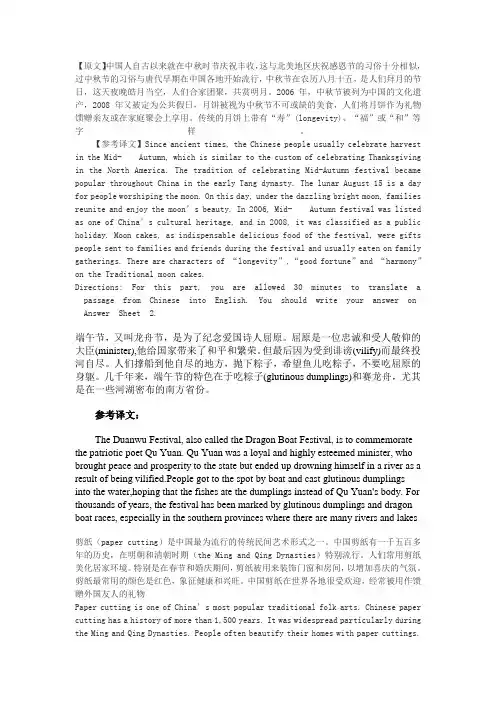
【原文】中国人自古以来就在中秋时节庆祝丰收,这与北美地区庆祝感恩节的习俗十分相似,过中秋节的习俗与唐代早期在中国各地开始流行,中秋节在农历八月十五,是人们拜月的节日,这天夜晚皓月当空,人们合家团聚,共赏明月。
2006年,中秋节被列为中国的文化遗产,2008年又被定为公共假日,月饼被视为中秋节不可或缺的美食,人们将月饼作为礼物馈赠亲友或在家庭聚会上享用。
传统的月饼上带有“寿”(longevity)、“福”或“和”等字样。
【参考译文】Since ancient times, the Chinese people usually celebrate harvest in the Mid- Autumn, which is similar to the custom of celebrating Thanksgiving in the North America. The tradition of celebrating Mid-Autumn festival became popular throughout China in the early Tang dynasty. The lunar August 15 is a day for people worshiping the moon. On this day, under the dazzling bright moon, families reunite and enjoy the moon’s beauty. In 2006, Mid- Autumn festival was listed as one of China’s cultural heritage, and in 2008, it was classified as a public holiday. Moon cakes, as indispensable delicious food of the festival, were gifts people sent to families and friends during the festival and usually eaten on family gatherings. There are characters of “longevity”,“good fortune”and “harmony”on the Traditional moon cakes.Directions: For this part, you are allowed 30 minutes to translate a passage fr om Chinese into English. You should write your answer on Answer Sheet 2.端午节,又叫龙舟节,是为了纪念爱国诗人屈原。
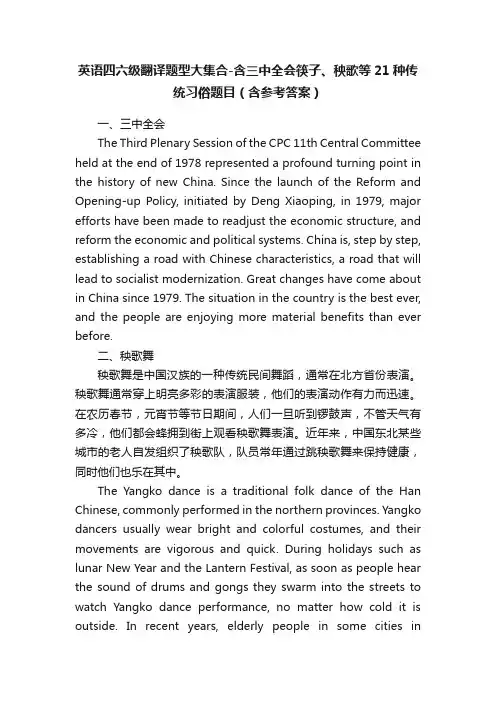
英语四六级翻译题型大集合-含三中全会筷子、秧歌等21种传统习俗题目(含参考答案)一、三中全会The Third Plenary Session of the CPC 11th Central Committee held at the end of 1978 represented a profound turning point in the history of new China. Since the launch of the Reform and Opening-up Policy, initiated by Deng Xiaoping, in 1979, major efforts have been made to readjust the economic structure, and reform the economic and political systems. China is, step by step, establishing a road with Chinese characteristics, a road that will lead to socialist modernization. Great changes have come about in China since 1979. The situation in the country is the best ever, and the people are enjoying more material benefits than ever before.二、秧歌舞秧歌舞是中国汉族的一种传统民间舞蹈,通常在北方省份表演。
秧歌舞通常穿上明亮多彩的表演服装,他们的表演动作有力而迅速。
在农历春节,元宵节等节日期间,人们一旦听到锣鼓声,不管天气有多冷,他们都会蜂拥到街上观看秧歌舞表演。
近年来,中国东北某些城市的老人自发组织了秧歌队,队员常年通过跳秧歌舞来保持健康,同时他们也乐在其中。
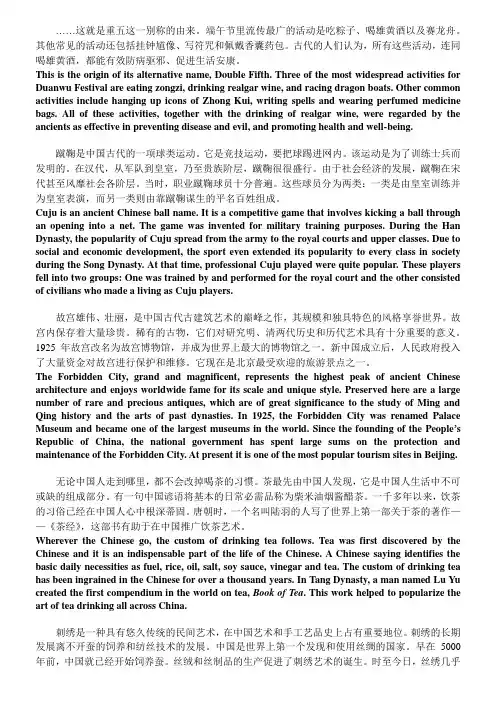
……这就是重五这一别称的由来。
端午节里流传最广的活动是吃粽子、喝雄黄酒以及赛龙舟。
其他常见的活动还包括挂钟馗像、写符咒和佩戴香囊药包。
古代的人们认为,所有这些活动,连同喝雄黄酒,都能有效防病驱邪、促进生活安康。
This is the origin of its alternative name, Double Fifth. Three of the most widespread activities for Duanwu Festival are eating zongzi, drinking realgar wine, and racing dragon boats. Other common activities include hanging up icons of Zhong Kui, writing spells and wearing perfumed medicine bags. All of these activities, together with the drinking of realgar wine, were regarded by the ancients as effective in preventing disease and evil, and promoting health and well-being.蹴鞠是中国古代的一项球类运动。
它是竞技运动,要把球踢进网内。
该运动是为了训练士兵而发明的。
在汉代,从军队到皇室,乃至贵族阶层,蹴鞠很很盛行。
由于社会经济的发展,蹴鞠在宋代甚至风靡社会各阶层。
当时,职业蹴鞠球员十分普遍。
这些球员分为两类:一类是由皇室训练并为皇室表演,而另一类则由靠蹴鞠谋生的平名百姓组成。
Cuju is an ancient Chinese ball name. It is a competitive game that involves kicking a ball through an opening into a net. The game was invented for military training purposes. During the Han Dynasty, the popularity of Cuju spread from the army to the royal courts and upper classes. Due to social and economic development, the sport even extended its popularity to every class in society during the Song Dynasty. At that time, professional Cuju played were quite popular. These players fell into two groups: One was trained by and performed for the royal court and the other consisted of civilians who made a living as Cuju players.故宫雄伟、壮丽,是中国古代古建筑艺术的巅峰之作,其规模和独具特色的风格享誉世界。
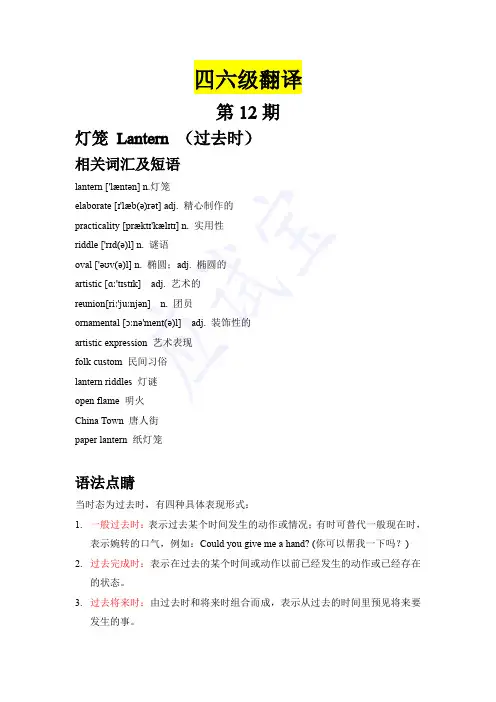
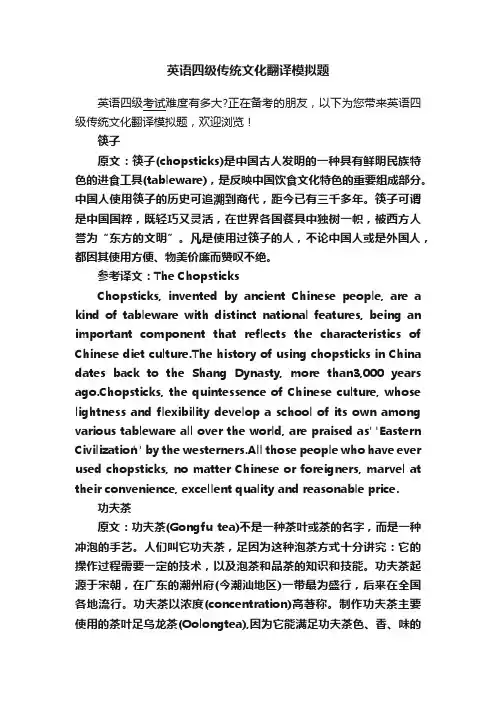
英语四级传统文化翻译模拟题英语四级考试难度有多大?正在备考的朋友,以下为您带来英语四级传统文化翻译模拟题,欢迎浏览!筷子原文:筷子(chopsticks)是中国古人发明的一种具有鲜明民族特色的进食工具(tableware),是反映中国饮食文化特色的重要组成部分。
中国人使用筷子的历史可追溯到商代,距今已有三千多年。
筷子可谓是中国国粹,既轻巧又灵活,在世界各国餐具中独树一帜,被西方人誉为“东方的文明”。
凡是使用过筷子的人,不论中国人或是外国人,都因其使用方便、物美价廉而赞叹不绝。
参考译文:The ChopsticksChopsticks, invented by ancient Chinese people, are a kind of tableware with distinct national features, being an important component that reflects the characteristics of Chinese diet culture.The history of using chopsticks in China dates back to the Shang Dynasty, more than3,000 years ago.Chopsticks, the quintessence of Chinese culture, whose lightness and flexibility develop a school of its own among various tableware all over the world, are praised as "Eastern Civilization" by the westerners.All those people who have ever used chopsticks, no matter Chinese or foreigners, marvel at their convenience, excellent quality and reasonable price.功夫茶原文:功夫茶(Gongfu tea)不是一种茶叶或茶的名字,而是一种冲泡的手艺。
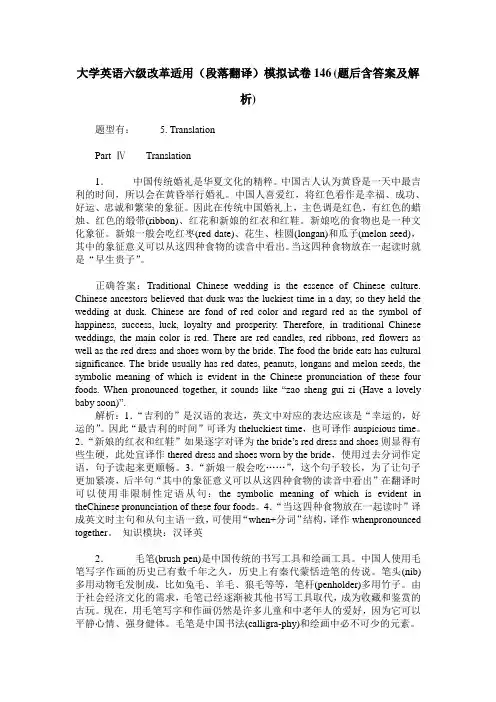
大学英语六级改革适用(段落翻译)模拟试卷146(题后含答案及解析)题型有: 5. TranslationPart ⅣTranslation1.中国传统婚礼是华夏文化的精粹。
中国古人认为黄昏是一天中最吉利的时间,所以会在黄昏举行婚礼。
中国人喜爱红,将红色看作是幸福、成功、好运、忠诚和繁荣的象征。
因此在传统中国婚礼上,主色调是红色,有红色的蜡烛、红色的缎带(ribbon)、红花和新娘的红衣和红鞋。
新娘吃的食物也是一种文化象征。
新娘一般会吃红枣(red date)、花生、桂圆(longan)和瓜子(melon seed),其中的象征意义可以从这四种食物的读音中看出。
当这四种食物放在一起读时就是“早生贵子”。
正确答案:Traditional Chinese wedding is the essence of Chinese culture. Chinese ancestors believed that dusk was the luckiest time in a day, so they held the wedding at dusk. Chinese are fond of red color and regard red as the symbol of happiness, success, luck, loyalty and prosperity. Therefore, in traditional Chinese weddings, the main color is red. There are red candles, red ribbons, red flowers as well as the red dress and shoes worn by the bride. The food the bride eats has cultural significance. The bride usually has red dates, peanuts, longans and melon seeds, the symbolic meaning of which is evident in the Chinese pronunciation of these four foods. When pronounced together, it sounds like “zao sheng gui zi (Have a lovely baby soon)”.解析:1.“吉利的”是汉语的表达,英文中对应的表达应该是“幸运的,好运的”。
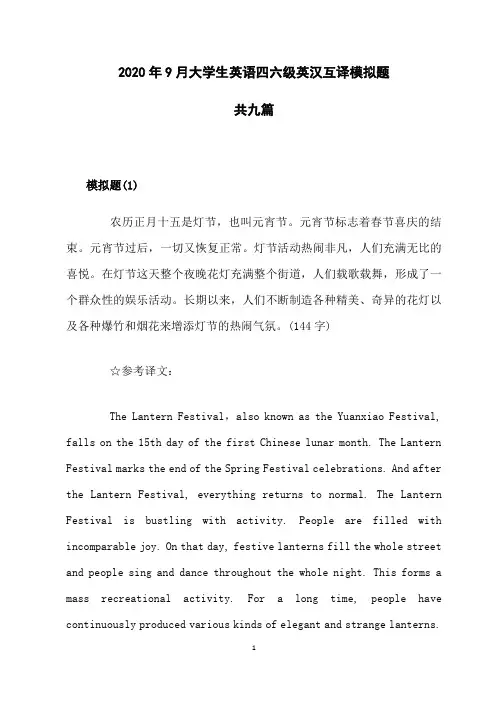
2020年9月大学生英语四六级英汉互译模拟题共九篇模拟题(1)农历正月十五是灯节,也叫元宵节。
元宵节标志着春节喜庆的结束。
元宵节过后,一切又恢复正常。
灯节活动热闹非凡,人们充满无比的喜悦。
在灯节这天整个夜晚花灯充满整个街道,人们载歌载舞,形成了一个群众性的娱乐活动。
长期以来,人们不断制造各种精美、奇异的花灯以及各种爆竹和烟花来增添灯节的热闹气氛。
(144字)☆参考译文:The Lantern Festival,also known as the Yuanxiao Festival, falls on the 15th day of the first Chinese lunar month. The Lantern Festival marks the end of the Spring Festival celebrations. And after the Lantern Festival, everything returns to normal. The Lantern Festival is bustling with activity. People are filled with incomparable joy. On that day, festive lanterns fill the whole street and people sing and dance throughout the whole night. This forms a mass recreational activity. For a long time, people have continuously produced various kinds of elegant and strange lanterns.模拟题(2)北京是几朝古都,各地美食风味云集、名厨高手荟萃,各民族饮食风俗在此相互影响,使得北京菜具有了别具一格、自成一体的特色。
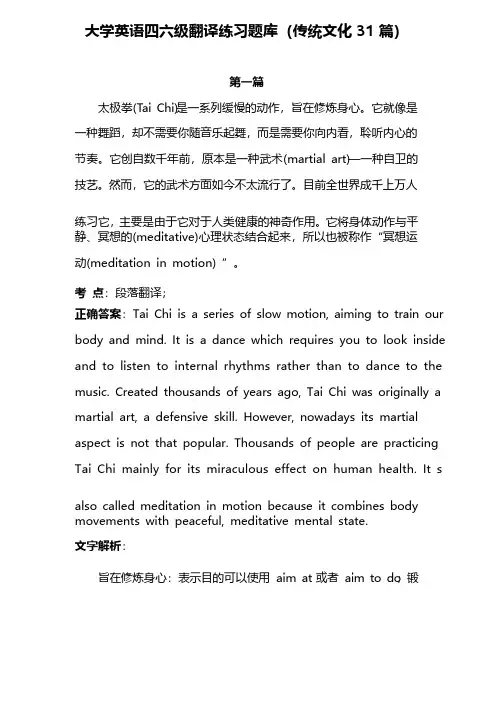
大学英语四六级翻译练习题库(传统文化31篇)第一篇太极拳太极拳(T (T (Tai ai Chi)是一系列缓慢的动作,旨在修炼身心。
它就像是一种舞蹈,却不需要你随音乐起舞,而是需要你向内看,聆听内心的节奏。
它创自数千年前,原本是一种武术节奏。
它创自数千年前,原本是一种武术(martial (martial art)—一种自卫的技艺。
然而,它的武术方面如今不太流行了。
目前全世界成千上万人练习它,主要是由于它对于人类健康的神奇作用。
主要是由于它对于人类健康的神奇作用。
它将身体动作与平它将身体动作与平静、冥想的静、冥想的(meditative)(meditative)(meditative)心理状态结合起来,所以也被称作“冥想运心理状态结合起来,所以也被称作“冥想运动(meditation in motion) ”。
考点:段落翻译;正确答案:Tai Chi is a series of slow motion, aiming to train our body and mind. It is a dance which requires you to look inside and to listen to internal rhythms rather than to dance to the music. Created thousands of years ago, Tai Chi was originally a martial art, a defensive skill. However, nowadays its martial aspect is not that popular. Thousands of people are practicing Tai Chi mainly for its miraculous effect on human health. It s also called meditation in motion because it combines body movements with peaceful, meditative mental state. 文字解析:旨在修炼身心:表示目的可以使用aim at 或者aim to do ;锻炼 身 心 可 以 翻 译 为 train body and mind 或 者 train us physically andmentally ,由于这句话前半句结构完整,可以把这半句处理为非谓语结构。
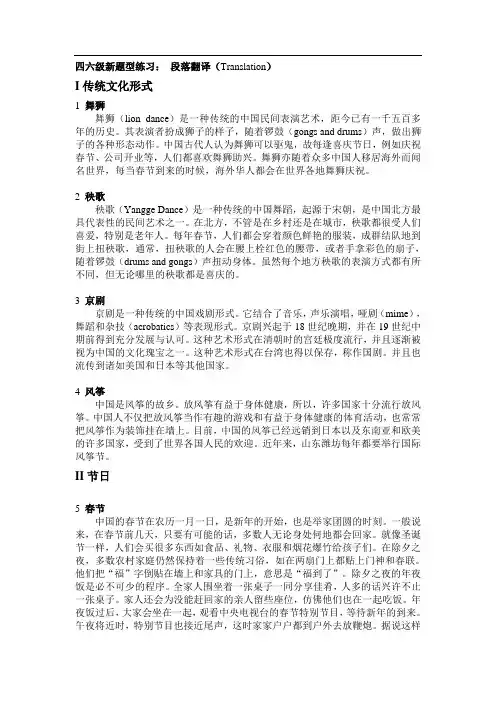
四六级新题型练习:段落翻译(Translation)I传统文化形式1 舞狮舞狮(lion dance)是一种传统的中国民间表演艺术,距今已有一千五百多年的历史。
其表演者扮成狮子的样子,随着锣鼓(gongs and drums)声,做出狮子的各种形态动作。
中国古代人认为舞狮可以驱鬼,故每逢喜庆节日,例如庆祝春节、公司开业等,人们都喜欢舞狮助兴。
舞狮亦随着众多中国人移居海外而闻名世界,每当春节到来的时候,海外华人都会在世界各地舞狮庆祝。
2 秧歌秧歌(Yangge Dance)是一种传统的中国舞蹈,起源于宋朝,是中国北方最具代表性的民间艺术之一。
在北方,不管是在乡村还是在城市,秧歌都很受人们喜爱,特别是老年人。
每年春节,人们都会穿着颜色鲜艳的服装,成群结队地到街上扭秧歌,通常,扭秧歌的人会在腰上栓红色的腰带,或者手拿彩色的扇子,随着锣鼓(drums and gongs)声扭动身体。
虽然每个地方秧歌的表演方式都有所不同,但无论哪里的秧歌都是喜庆的。
3 京剧京剧是一种传统的中国戏剧形式。
它结合了音乐,声乐演唱,哑剧(mime),舞蹈和杂技(acrobatics)等表现形式。
京剧兴起于18世纪晚期,并在19世纪中期前得到充分发展与认可。
这种艺术形式在清朝时的宫廷极度流行,并且逐渐被视为中国的文化瑰宝之一。
这种艺术形式在台湾也得以保存,称作国剧。
并且也流传到诸如美国和日本等其他国家。
4 风筝中国是风筝的故乡。
放风筝有益于身体健康,所以,许多国家十分流行放风筝。
中国人不仅把放风筝当作有趣的游戏和有益于身体健康的体育活动,也常常把风筝作为装饰挂在墙上。
目前,中国的风筝已经远销到日本以及东南亚和欧美的许多国家,受到了世界各国人民的欢迎。
近年来,山东潍坊每年都要举行国际风筝节。
II节日5 春节中国的春节在农历一月一日,是新年的开始,也是举家团圆的时刻。
一般说来,在春节前几天,只要有可能的话,多数人无论身处何地都会回家。
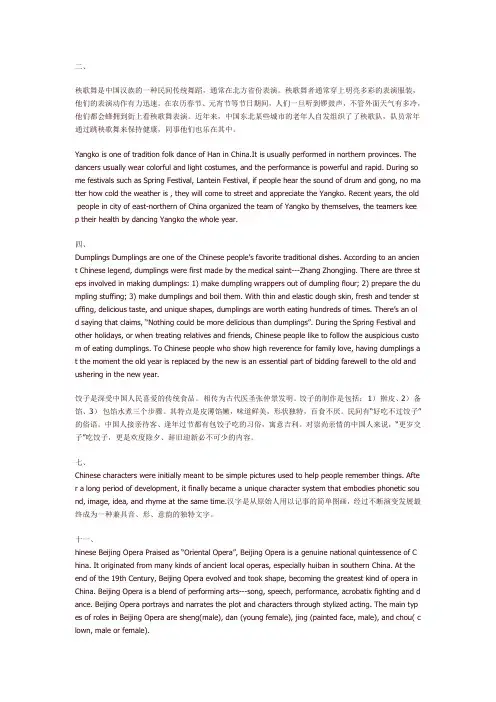
二、秧歌舞是中国汉族的一种民间传统舞蹈,通常在北方省份表演。
秧歌舞者通常穿上明亮多彩的表演服装,他们的表演动作有力迅速。
在农历春节、元宵节等节日期间,人们一旦听到锣鼓声,不管外面天气有多冷,他们都会蜂拥到街上看秧歌舞表演。
近年来,中国东北某些城市的老年人自发组织了了秧歌队,队员常年通过跳秧歌舞来保持健康,同事他们也乐在其中。
Yangko is one of tradition folk dance of Han in China.It is usually performed in northern provinces. The dancers usually wear colorful and light costumes, and the performance is powerful and rapid. During so me festivals such as Spring Festival, Lantein Festival, if people hear the sound of drum and gong, no ma tter how cold the weather is , they will come to street and appreciate the Yangko. Recent years, the old people in city of east-northern of China organized the team of Yangko by themselves, the teamers kee p their health by dancing Yangko the whole year.四、Dumplings Dumplings are one of the Chinese people’s favorite traditional dishes. According to an ancien t Chinese legend, dumplings were first made by the medical saint---Zhang Zhongjing. There are three st eps involved in making dumplings: 1) make dumpling wrappers out of dumpling flour; 2) prepare the du mpling stuffing; 3) make dumplings and boil them. With thin and elastic dough skin, fresh and tender st uffing, delicious taste, and unique shapes, dumplings are worth eating hundreds of times. There’s an ol d saying that claims, “Nothing could be more delicious than dumplings”. During the Spring Festival and other holidays, or when treating relatives and friends, Chinese people like to follow the auspicious custo m of eating dumplings. To Chinese people who show high reverence for family love, having dumplings a t the moment the old year is replaced by the new is an essential part of bidding farewell to the old and ushering in the new year.饺子是深受中国人民喜爱的传统食品。
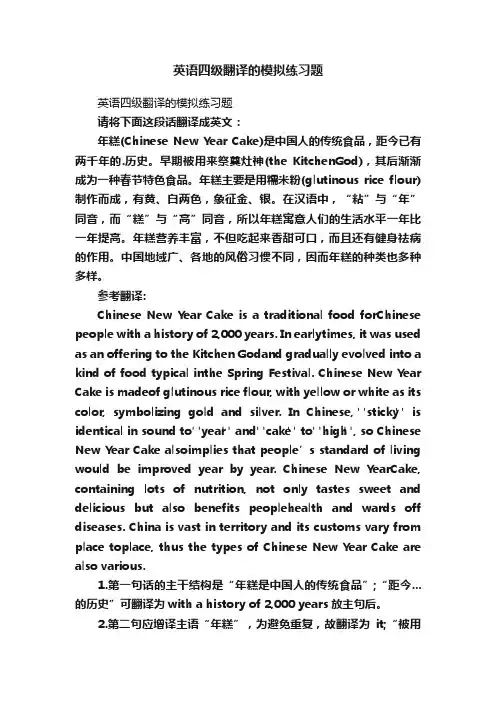
英语四级翻译的模拟练习题英语四级翻译的模拟练习题请将下面这段话翻译成英文:年糕(Chinese New Year Cake)是中国人的传统食品,距今已有两千年的.历史。
早期被用来祭奠灶神(the KitchenGod),其后渐渐成为一种春节特色食品。
年糕主要是用糯米粉(glutinous rice flour)制作而成,有黄、白两色,象征金、银。
在汉语中,“粘”与“年”同音,而“糕”与“高”同音,所以年糕寓意人们的生活水平一年比一年提高。
年糕营养丰富,不但吃起来香甜可口,而且还有健身祛病的作用。
中国地域广、各地的风俗习惯不同,因而年糕的种类也多种多样。
参考翻译:Chinese New Year Cake is a traditional food forChinese people with a history of 2,000 years. In earlytimes, it was used as an offering to the Kitchen Godand gradually evolved into a kind of food typical inthe Spring Festival. Chinese New Year Cake is madeof glutinous rice flour, with yellow or white as its color, symbolizing gold and silver. In Chinese, "sticky" is identical in sound to "year" and "cake" to "high", so Chinese New Year Cake alsoimplies that people’s standard of living would be improved year by year. Chinese New YearCake, containing lots of nutrition, not only tastes sweet and delicious but also benefits peoplehealth and wards off diseases. China is vast in territory and its customs vary from place toplace, thus the types of Chinese New Year Cake are also various.1.第一句话的主干结构是“年糕是中国人的传统食品”;“距今...的历史”可翻译为with a history of 2,000 years放主句后。
Temple Fair 庙会在中国各地,过去不论乡村、城市,到处都有庙。
Temples abounded across China, both in the countryside and in the city.每年到了佛祖或者神灵的祭日,都在庙前广场上搭台演戏。
这时候,大家都来看戏,小贩也前来摆地摊,做生意。
Every year on the fete-days of Buddha or other gods, stages were set up for performances on the square before the temples. Many people came for the play, and the vendors put up stalls to do business.逛庙会的人们,即可以进香,也可以看戏,还可以买东西。
因此在庙会期间,天天都是非常热闹的。
Those who came for the temple fair offered incense to Buddha, watched the play and did some shopping at the same time. Hence the temple fairs were full of hustle and bustle every day. 人们坐车走几十里路,除了烧香还愿之外,还达到了交际、娱乐、旅游和购物的目的。
People took wagon or walked for miles to the temple fair, fulfilling the purposes of communication, entertainment, travel and shopping apart form offering incense.这种庙会通常都是一年一次,为期最多不过半个月,日期一过,马上就冷落下来了。
大学英语四六级翻译练习题库(传统文化31篇)第一篇太极拳(T ai Chi)是一系列缓慢的动作,旨在修炼身心。
它就像是一种舞蹈,却不需要你随音乐起舞,而是需要你向内看,聆听内心的节奏。
它创自数千年前,原本是一种武术(martial art)—一种自卫的技艺。
然而,它的武术方面如今不太流行了。
目前全世界成千上万人练习它,主要是由于它对于人类健康的神奇作用。
它将身体动作与平静、冥想的(meditative)心理状态结合起来,所以也被称作“冥想运动(meditation in motion) ”。
考点:段落翻译;正确答案:Tai Chi is a series of slow motion, aiming to train our body and mind. It is a dance which requires you to look inside and to listen to internal rhythms rather than to dance to the music. Created thousands of years ago, Tai Chi was originally a martial art, a defensive skill. However, nowadays its martial aspect is not that popular. Thousands of people are practicing Tai Chi mainly for its miraculous effect on human health. It s also called meditation in motion because it combines body movements with peaceful, meditative mental state.文字解析:旨在修炼身心:表示目的可以使用aim at 或者aim to do;锻炼身心可以翻译为train body and mind 或者train us physically andmentally,由于这句话前半句结构完整,可以把这半句处理为非谓语结构。
1.春节是是中国的农历新年。
在中国的传统节日中,这是一个最重要、最热闹的节日。
中国人过春节有很多传统习俗。
除夕之夜,是家人团聚的时候。
一家人围坐在一起,吃一顿丰盛的年夜饭(New Year’s Eve dinner),说说笑笑,直到天亮,这叫守岁(staying up to see the year out)。
除夕零点的钟声一响,人们还要吃饺子。
从初一开始,人们要走亲戚、看朋友,互相拜年(greet each othe r)。
拜年,是春节的重要习俗。
放爆竹(set off firecrackers)是春节期间孩子们最喜欢的活动。
传说燃放爆竹可以驱妖除魔(drive off evil spirits)。
Spring Festival is the New Year in Chinese lunar calendar. Among the traditional Chinese festivals, this is the most important and the most bustling festival.Chinese have many traditional customs relating to the Spring Festival. New Year’s Eve is the time for a happy reunion of all the family members, when they sit around the table to have a bumper New Year’s Eve dinner, talking and laughing, until daybreak, which is called “staying up to see the year out”. When the bell tolls midnight on New Year’s Eve, people eat dumplings. From the first day of the lunar year, people visit relatives and friends, to greet each other, which is an important custom for the Spring Festival. Setting off firecrackers is the favorite activity of children in the Spring Festival, which could drive off evil spirits according to legend.2.农历八月十五(the 15th day of the eighth lunar month),是中国的传统节日中秋节(Mid-Autumn Festival)。
……这就是重五这一别称的由来。
端午节里流传最广的活动是吃粽子、喝雄黄酒以及赛龙舟。
其他常见的活动还包括挂钟馗像、写符咒和佩戴香囊药包。
古代的人们认为,所有这些活动,连同喝雄黄酒,都能有效防病驱邪、促进生活安康。
This is the origin of its alternative name, Double Fifth. Three of the most widespread activities for Duanwu Festival are eating zongzi, drinking realgar wine, and racing dragon boats. Other common activities include hanging up icons of Zhong Kui, writing spells and wearing perfumed medicine bags. All of these activities, together with the drinking of realgar wine, were regarded by the ancients as effective in preventing disease and evil, and promoting health and well-being.蹴鞠是中国古代的一项球类运动。
它是竞技运动,要把球踢进网内。
该运动是为了训练士兵而发明的。
在汉代,从军队到皇室,乃至贵族阶层,蹴鞠很很盛行。
由于社会经济的发展,蹴鞠在宋代甚至风靡社会各阶层。
当时,职业蹴鞠球员十分普遍。
这些球员分为两类:一类是由皇室训练并为皇室表演,而另一类则由靠蹴鞠谋生的平名百姓组成。
Cuju is an ancient Chinese ball name. It is a competitive game that involves kicking a ball through an opening into a net. The game was invented for military training purposes. During the Han Dynasty, the popularity of Cuju spread from the army to the royal courts and upper classes. Due to social and economic development, the sport even extended its popularity to every class in society during the Song Dynasty. At that time, professional Cuju played were quite popular. These players fell into two groups: One was trained by and performed for the royal court and the other consisted of civilians who made a living as Cuju players.故宫雄伟、壮丽,是中国古代古建筑艺术的巅峰之作,其规模和独具特色的风格享誉世界。
英语六级翻译模拟练习及答案解析英语六级翻译模拟练习一:请将下面这段话翻译成英文:农历八月十五站中国传统的中秋节the Mid-AutumnFestival。
这是继中国农历新年之后最重要的节日。
人们坚信,农历八月十五的月亮比其他月份的更圆更亮。
满月象征着重聚和团圆。
因此中秋节是家人聚在一起的日子,也被称为“团圆节”。
一般说来,吃月饼、赏月是中秋节的常见传统。
此外,中国不同地区及各个少数民族有不同的中秋节习俗。
中国有很多关于月亮的传说。
月亮上的神仙嫦娥Chang'e、吴刚和玉兔the Jade Rabbit的故事至今仍在流传。
参考翻译:The 15th day of lunar August is the traditionalChinese Mid-Autumn Festival, the most importantfestival after the Chinese Lunar New Year. Themoon on the night of the 15th day of lunar Augustisbelieved to be much fiiller and brighter than thatin the other months. A foil moon is a symbol ofreunion. So the Mid-Autumn Festival is also called the “Reunion Festival' a time forfamilymembers to get together. Generally speaking, eating moon cakes and enjoying the moonare common traditions on the festival. In addition, the customs of the Mid-Autumn Festivalvary indifferent parts and ethnic groups of China. There are lots of Chinese legends aboutthe moon. The story of Goddess Chang'e,Wu Gang and the Jade Rabbit living on the moonis still popular today.解析:1.农历八月十五:有多种表达方式,如the 15th day oflunar August, the Lunar August 15, the fifteenthday of August of the lunar calendar等。
英语六级翻译练习和范文【翻译原文】我国食品种类繁多,节日食俗也丰富多彩。
春节(the SpringFestival)是我国的传统节日,人们通常从它的前夜—除夕就开始张罗了。
除夕那天,家家户户都要吃很丰盛的年夜饭。
因为“鱼”和“有余”的“余”读者相同,为了预示新年节庆有余,有些民族初一有吃鱼的习俗。
端午节(the Dragon BoatFestival)的重要食俗就是吃粽子(rice dumpling)。
粽子越做越好,品种也越做越多。
在中国,吃月饼是中秋节(the Mid-Autumn Festival)最具典型意义的食俗了。
农历八月十五这一天,人们都喜欢合家团聚,边饮酒赏月,边吃月饼。
中秋吃月饼的习俗已有悠久的历史。
【参考译文】China has a wide variety of food, and eatingcustoms on festivals are also colorful. The SpringFestival is a traditional festival in China, and peopleusually begin to bustle on New Years Eve, theevening before the Spring Festival. On that day,every family will have a hearty reunion dinner. In order to predict a surplus for the comingyear, some ethnic groups have adopted the custom of eating fish on the first day of lunarJanuary, because the sound of Chinese character for “fish” is the same with that of “surplus”.Besides, the important custom of the Dragon Boat Festival is eating rice dumplings, so ricedumplings are turning better and better and the variety of them is becoming more and morediverse. In China, eating moon cakes is the most typical custom on the Mid-Autumn Festival.On the 15th day of lunar August, people like to get together andhave a family reunion,drinking, appreciating the full moon and eating moon cakes which is a tradition of a long history.【翻译原文】当来中国的游客发现一桌标准的8人晚宴有4道凉菜、4道热菜,并配以汤和米饭时,他们往往会感到惊讶。
中国人的生活多姿多彩,有许多很有意思的民俗(folkways)。
最有意思的可能要数中式婚礼了。
中国人结婚与西方人不大一样,西方人要进教堂,而中国人要大摆筵席;西方人要上帝赐福,而中国人要拜天地,拜父母;西方人穿着洁白的婚纱举行婚礼,而中国传统的婚礼需要新郎新娘穿红衣服,因为红色在中国象征着吉祥、喜庆。
The Chinese life is colorful with many interesting folkways. The Chinese wedding may be a focus of
interest. There are many differences between the Chinese and the West in weddings, as the people in the West go to church while the Chinese celebrate with a feast. Westerners hope that God will bless them while the Chinese thank heaven and their parents. Westerners wear while wedding dresses while the bride and groom wear red according to Chinese tradition, because red symbolize good luck and happiness.。